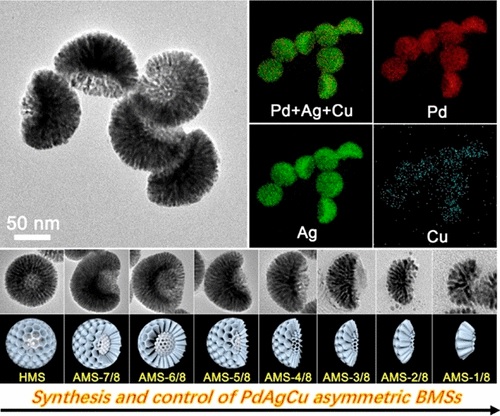刘犇教授课题组在NANO LETTERS发表研究论文
Asymmetric Multimetallic Mesoporous Nanospheres
Lv, H (Lv, Hao)[ 1 ] ; Xu, DD (Xu, Dongdong)[ 1 ] ; Sun, LZ (Sun, Lizhi)[ 1 ] ; Henzie, J (Henzie, Joel)[ 2,3 ] ; Lopes, A (Lopes, Aaron)[ 4 ] ; Gu, QY (Gu, Qingyu)[ 1 ] ; Yamauchi, Y (Yamauchi, Yusuke)[ 2,5,6,7 ] ; Liu, B (Liu, Ben)[ 1 ]*(刘犇)
[ 1 ] Nanjing Normal Univ, Sch Chem & Mat Sci, Jiangsu Collaborat Innovat Ctr Biomed Funct Mat, Jiangsu Key Lab New Power Batteries, Nanjing 210023, Jiangsu, Peoples R China
[ 2 ] Qingdao Univ Sci & Technol, Coll Chem & Mol Engn, Key Lab Ecochem Engn, Qingdao 266042, Shandong, Peoples R China
[ 3 ] NIMS, Int Ctr Mat Nanoarchitecton WPI MANA, 1-1 Namiki, Tsukuba, Ibaraki 3050044, Japan
[ 4 ] MIT, Dept Chem Engn, Cambridge, MA 02139 USA
[ 5 ] Univ Queensland, Sch Chem Engn, Brisbane, Qld 4072, Australia
[ 6 ] Univ Queensland, AIBN, Brisbane, Qld 4072, Australia
[ 7 ] Kyung Hee Univ, Dept Plant & Environm New Resources, 1732 Deogyeong Daero, Yongin 446701, Gyeonggi Do, South Korea
NANO LETTERS,201905,19(5),3379-3385
Mesoporous colloidal nanospheres with tailorable asymmetric nanostructures and multimetallic elemental compositions are building blocks in next-generation heterogeneous catalysts. Introducing structural asymmetry into metallic mesoporous frameworks has never been demonstrated, but it would be beneficial because the asymmetry enables the spatial control of catalytic interfaces, facilitates the electron/mass transfer and assists in the removal of poisonous intermediates. Herein, we describe a simple bottom-up strategy to generate uniform sub-100 nm multimetallic asymmetric bowl-shaped mesoporous nano spheres (BMSs). This method uses a surfactant-directed "dual"-template to control the kinetics of metal reduction on the surface of a vesicle, forming mesoporous metal islands on its surface whose spherical cone angle can be precisely controlled. The asymmetric BMS mesostructures with different spherical cone angles (structural asymmetries) and elemental compositions are demonstrated. The high surface area and asymmetric nature of the metal surfaces are shown to enhance catalytic performance in the alcohol oxidation reactions. The findings described here offer novel and interesting opportunities for rational design and synthesis of hierarchically asymmetric nanostructures with desired functions for a wide range of applications.

文章链接:
https://pubs.acs.org/doi/10.1021/acs.nanolett.9b01223
版权与免责声明:本网页的内容由收集互联网上公开发布的信息整理获得。目的在于传递信息及分享,并不意味着赞同其观点或证实其真实性,也不构成其他建议。仅提供交流平台,不为其版权负责。如涉及侵权,请联系我们及时修改或删除。邮箱:sales@allpeptide.com